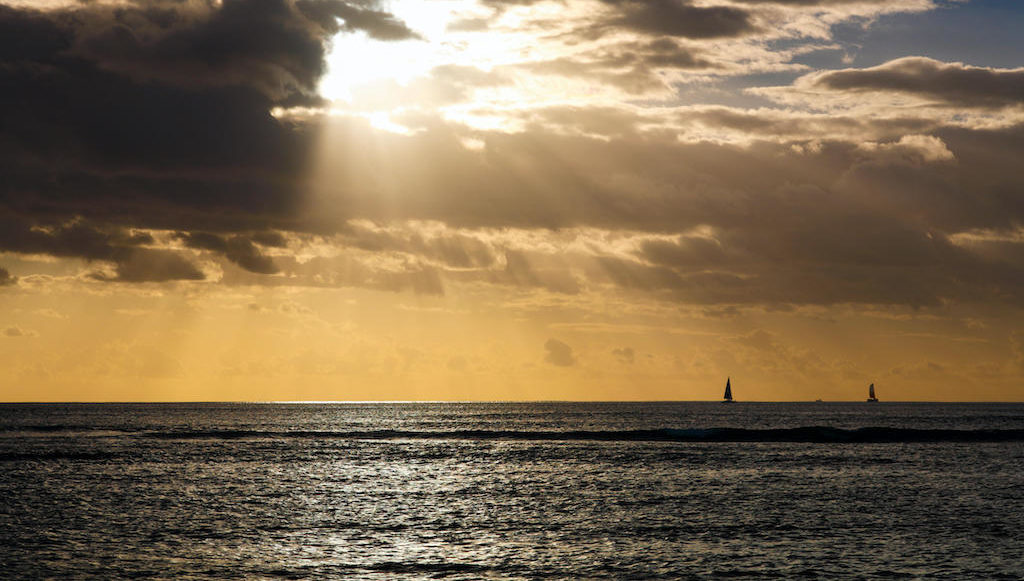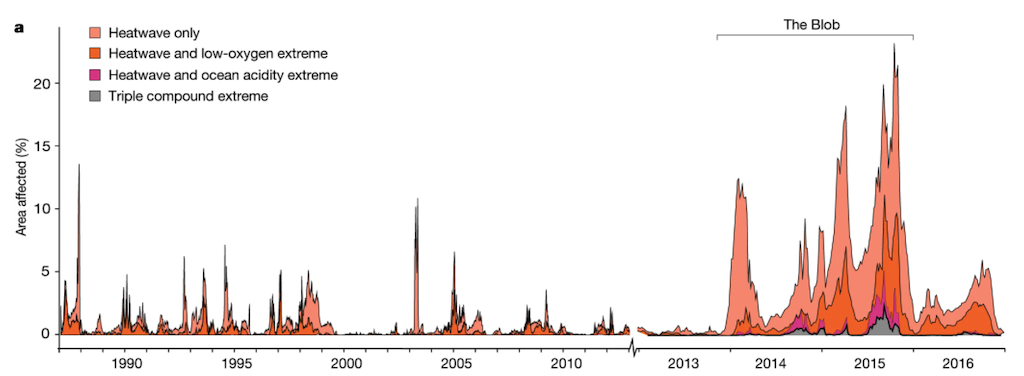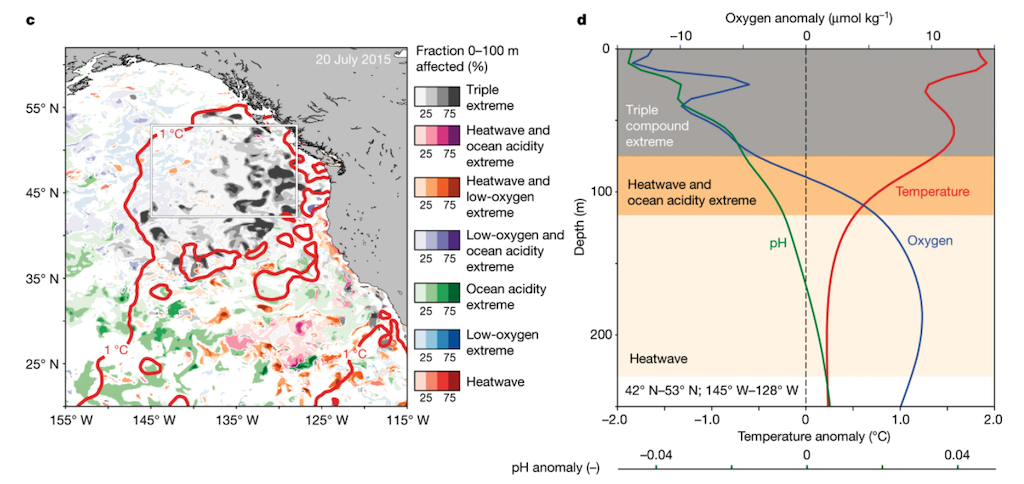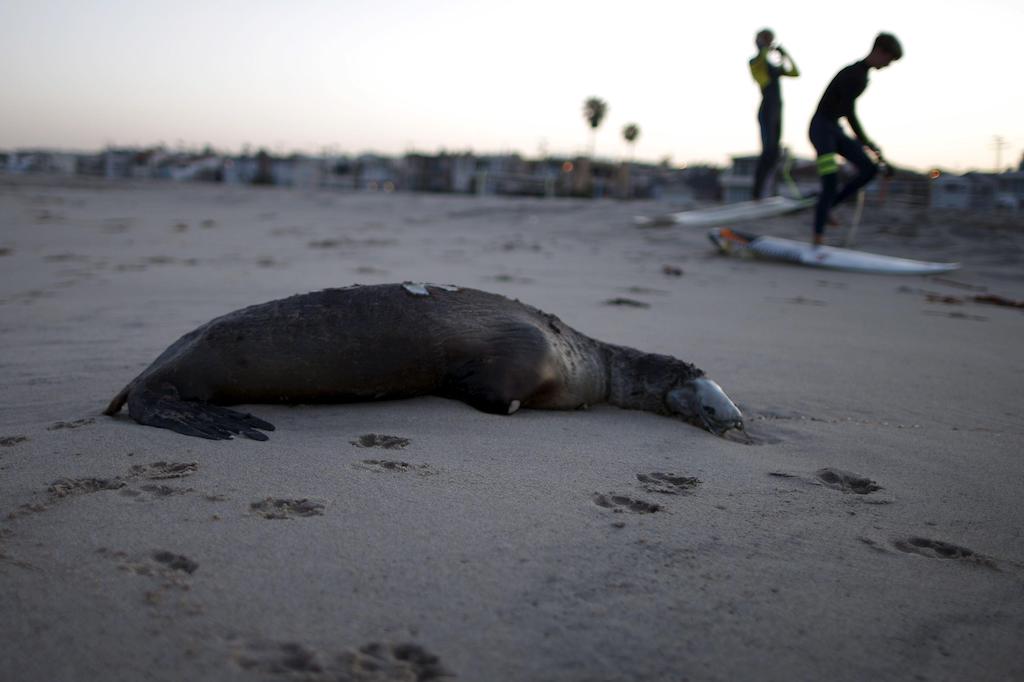
Guest post: Why oceans could face more extremes like the Pacific ‘Blob’

Guest authors
01.24.22
Guest authors
24.01.2022 | 8:00amThe devastating impact of extreme weather is etched into our collective memory. In 2021 alone, the world saw record-shattering heat in western North America, deadly floods in Europe, China and west Africa, and wildfires in the Mediterranean.
But alongside these events happening on land, the oceans experience extreme conditions too. In 2015, the North Pacific saw the largest marine heatwave ever recorded, known simply as the “Blob”.
As Earth warms, marine heatwaves are likely to become more intense, happen more often and last longer. But as our recent paper in Nature explains, we are also set to see more occasions – as with the “Blob” – where two or more types of extreme events occur simultaneously.
These “compound” events likely have more devastating impacts than a single heatwave, affecting marine life such as tiny floating plants, seabirds and sea lions.
The ‘Blob’ in the Pacific
In 2015-16, much of the tropical Pacific was experiencing record high sea surface temperatures associated with a strong El Niño event, causing widespread bleaching and death of coral reefs.
At the same time, the North Pacific was seeing extreme warmth, in an event that became known as the “Blob”. At its peak in 2015, the Blob covered about 4m square kilometres (km2) of ocean, stretching from Alaska to Baja California.
The Blob had huge consequences for marine ecosystems, causing a drop in primary production – the process by which marine plants produce food to live and grow – and forcing fish and other organisms to move in search of cooler habitats. Extended blooms of harmful algae also had devastating effects on mussel and crab fisheries, which, in turn, led to massive die-offs of seabirds, seals and sea lions.
Unsurprisingly, the Blob caught the headlines at the time. National Geographic, for example, described it as, “The blob that cooked the Pacific”. Some of the ecological consequences of the Blob are still lingering today, with several marine animal populations not having fully recovered.
A ‘triple-compound’ extreme event
Our research used simulations from a regional ocean biogeochemical model to explore not only the extreme heat that characterised the Blob, but also whether the upper water column in the northeast Pacific at the time was unusual in other ways too. In particular, with respect to its oxygen levels and acidity (measured by the pH of the seawater).
When two or more types of extreme events occur together – over land or in the ocean – it is known as a “compound” event. Dual-compound (two types) or even triple-compound (three types) events are adding new and largely unquantified stress to marine ecosystems. Our research set out to examine if the Blob in the North Pacific in 2013-15 was a compound extreme event, which could potentially explain part of the devastating effects on marine life.
The figure below shows a timeseries for the part of the northeast Pacific where the Blob occurred. Light orange shading denotes when a marine heatwave occurred (a single event). Dark orange and purple denote dual-compound events involving a marine heatwave and either low oxygen or extremely low pH, respectively. Grey signifies times when all three types of extreme occurred simultaneously.

The chart shows grey shading for several months in 2015 in the northeast Pacific. This indicates that the heatwave coincided with extremes in acidity and oxygen, making at least part of the Blob a triple-compound event. The chart also shows several dual extremes (dark orange and purple) prior to the peak in 2015, making the Blob period from 2013 until 2015 highly unusual in the record extending back to the 1980s.
The triple-compound event covered a large area of ocean, as shown by the grey areas in the map on the left-hand side below. The darker the grey, the deeper the extreme conditions penetrated the ocean.

The map shows how the triple-compound extreme event extended in a big arc from the coast of southwestern Canada out to the open ocean, covering in total nearly 0.2m km2. The accompanying chart shows that the event extended down to 70 metres and more of the ocean.
It is not unreasonable, given the scale and extent of the Blob, to expect that some of the observed consequences for marine ecosystems could be the result of the concurrent extremes in ocean acidity and low oxygen amplifying the effects of the long-lasting heatwave.
A future with more extremes
As part of our research, we carried out a global model analysis of extremes in ocean temperature, acidity and oxygen, which allowed us to put the results from the Blob into a global perspective.
Extreme events in the ocean are a global phenomenon, although there are hotspots where the strongest extremes occur. At the surface, the most severe extremes occur in the eastern tropical Pacific and in the mid-to-high latitudes. Deeper in the ocean, the strongest events occur mostly at low latitudes.
Our results show that between pre-industrial times and the present, marine heatwaves have become 10 times more common and low oxygen extremes have become about five times more common. Ocean acidity extremes have become essentially near permanent, meaning they have increased nearly 100-fold.
These striking increases are a direct consequence of the upward trends in ocean warming, oxygen depletion – known as “deoxygenation” – and ocean acidification, which themselves are caused primarily by emissions of CO2 into the atmosphere. We can, therefore, say with high confidence that the increase in marine heatwaves and ocean acidification extremes are primarily caused by human activities.
Looking ahead, this implies that all three types of extreme events will increase as long as atmospheric CO2 and Earth’s temperature keep increasing. This also suggests that compound events – where two or more extremes occur simultaneously – are much more likely to occur in future too.
This matters because these extreme events are adding substantial new stresses to marine organisms and ecosystems that could appear a long time before the slower-evolving trends in ocean warming, ocean acidification and ocean deoxygenation. The speed of onset of an extreme event or their recurrence rate can overwhelm the mechanisms available to organisms to cope with extreme conditions, for example.

Addressing the threat: In three main ways
Despite the potentially harmful consequences for marine organisms and ecosystems from compound extreme events, they remain poorly understood. It is our view that we vastly need to ramp up research in three key areas.
The first issue is the criteria for classifying conditions as “extreme”. In our article, we adopted a relative threshold approach, which defines extreme days as those when the property of interest exceeds the 99th percentile (in the case of temperature and acidification) or lies below the 1st percentile (in the case of oxygen) of the long-term seasonal average. While this is the most commonly used approach in extreme event research, it may overestimate the effect of extremes on marine organisms that are able to adapt quickly.
A fundamentally different approach involves absolute thresholds, such as the minimum oxygen concentration to sustain metabolism or the point at which seawater is so acidified as to become corrosive. Such criteria need to be chosen with a particular impact in mind.
Secondly, direct observations of extreme conditions below the surface of the ocean are still very limited. Fortunately, these are rapidly improving thanks to recent developments such as Biogeochemical Argo – a deployment of fleets of autonomous profiling floats that monitor the ocean in real time. Looking at the ocean’s interior is critical since the majority of marine organisms live across several hundred metres.
The third and biggest challenge is our very limited understanding of how extremes affect organisms and ecosystems. In particular, very little is known about the effect of dual- or triple-compound events. In our paper, we outline different processes that need to be better understood – at the level of a cell all the way up to those governing ecosystem structure and function. For example, the expression of heat shock proteins helps to stabilise essential physiological functions during individual extremes, and ecosystems may adapt to an increased frequency of extremes through shifts in their species composition in favour of less vulnerable species.
Better understanding of marine extremes – especially with respect to their impact on marine organisms and ecosystems – will help to design strategies to cope with the consequences. This could include, for example, the temporary closure of fishing grounds in order to reduce the other stressors on the system.
This effort will also help to improve our understanding of the impact of the slower-evolving processes of ocean warming, ocean deoxygenation and ocean acidification, as the conditions encountered during extremes today are anticipated to become the norm a few decades from now.
Gruber, N. et al. (2021) Biogeochemical extremes and compound events in the ocean, Nature, doi: 10.1038/s41586-021-03981-7
Dedication:
Prof Boyd dedicates this article on marine extremes to the legacy of Dr Rebecca Harris, director of the Climate Futures Team at the University of Tasmania, and her pivotal research into the ramifications of extremes on the terrestrial biosphere.

